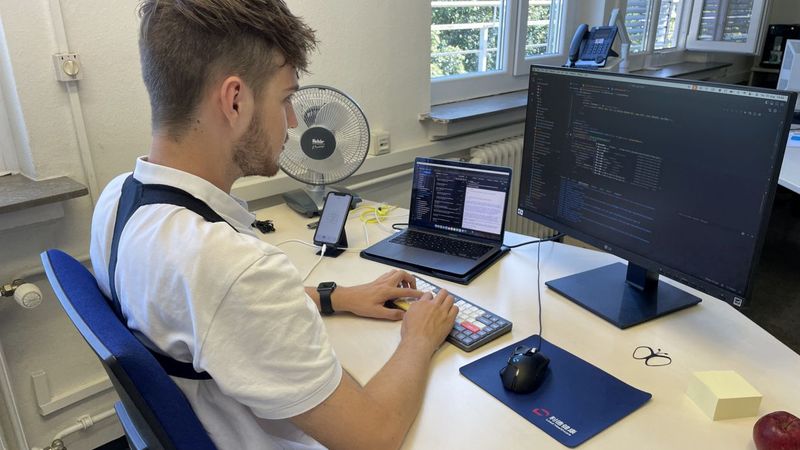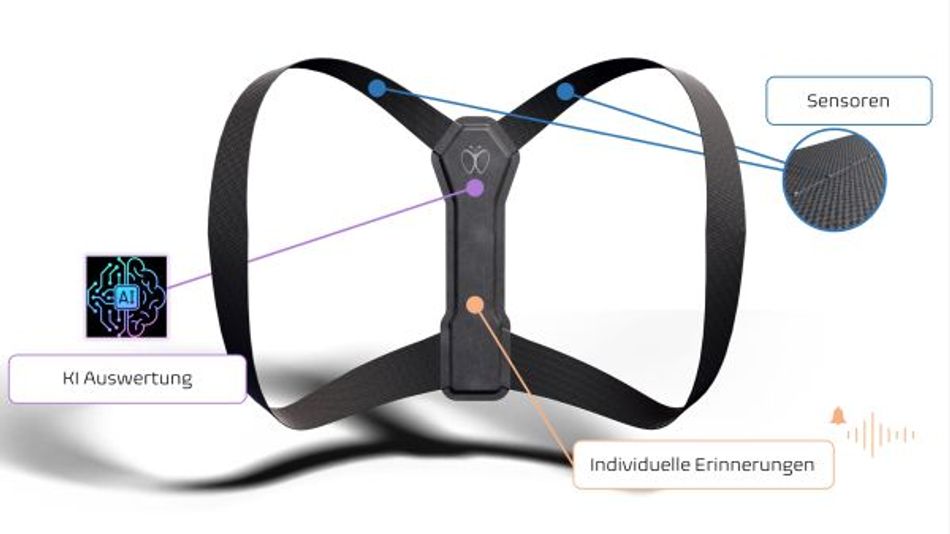Innovative Wearable: Sustainably Improving Posture
KIT spin-off StraightUp aims to permanently relieve posture-related back pain

In the future, StraightUp could improve posture in everyday office life and thus reduce back pain, as demonstrated here in the prototype. (Photo: StraightUp)
This article was first published on
www.kit.eduThis article was discussed in our Next Byte podcast.
The full article will continue below.
Back pain is one of the main causes of everyday discomfort and sick leave in the western world. The reason for this is often a lack of exercise in the sedentary office routine combined with a lack of compensatory activities such as sport and gymnastics. The aim of the spin-off StraightUp by three graduates of the Karlsruhe Institute of Technology (KIT) is to combat back pain in the long term and sustainably with an innovative idea. To this end, they have developed a wearable textile product that uses woven elastic wires and appropriate sensors to measure the shoulder position and inclination of the back and ensures a sustainable improvement in posture through haptic feedback.
Previous posture stabilizers are designed to simply fix the back, which in the long term severely limits the mobility of the user. Other approaches with built-in inclination sensors that trigger a vibration impulse when the body bends forward have the disadvantage that many everyday and sports activities take place in a forward-leaning position and thus lead to incorrect vibration impulses.
Novel approach using elastic metal alloy and AI implementation
The spin-off StraightUp is tackling this problem with an innovative idea. Erik Vautrin, Marcus Hamann-Schroer and Jan Bartenbach, three KIT graduates, in collaboration with physiotherapist Tobias Baierle, developed the vision of a wearable textile that can measure the shoulder position and inclination of the back using elastic wires incorporated into the fabric. Using the data obtained from this and a woven-in chip controlled by artificial intelligence (AI), the system generates haptic feedback through vibrations, which is intended to encourage users to correct their posture. The use of the sensors in the wearable was made possible by a conductive super-elastic metal alloy that adapts to the movements of the person wearing it. "Through the haptic feedback, the body learns to maintain a healthier posture on its own, which leads to long-term improvement. The feedback system promotes active shoulder blade stabilization and posture correction of the spine," explains Baierle. The wearable can be worn in everyday life as well as during leisure and sports activities.

Further steps on the way to spin-off and market readiness
The team is currently working with the German Institute for Textile and Fiber Research to enable the best possible integration of the sensors into the wearable. "This partnership brings us a big step closer to market readiness," explains Vautrin. In collaboration with doctors, physiotherapists and other specialists, optimization tests are to take place this year. The aim is to test the further developed product with potential customers at the end of the year.
Support for founders at KIT
The three founders of StraightUp met in the course “Microsystem product design for young entrepreneurs” at KIT. “In the course we learned the basics of developing and implementing a product idea. We also learned practical things like writing a business plan,” explains Bartenbach. The young team then met the physiotherapist Baierle through a lecturer.
On their journey so far, the founders have used the support options at KIT. These include the KIT start-up forge and other offers from the KIT's Innovation and Relations Management (IRM) service unit. With the support of IRM, the StraightUp team successfully acquired an EXIST start-up grant for preparation and early-stage financing of the upcoming spin-off. "From the very beginning, we had a great impression of the competence of the individual people and how they interact with each other in the StraightUp team," says Dr. Rolf Blattner, Business Development Manager at IRM.